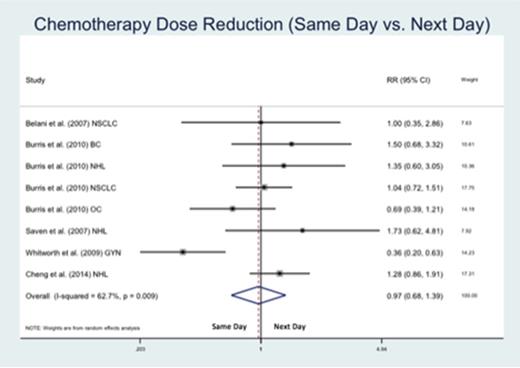Abstract
Introduction: CIN/FN is a major dose-limiting toxicity of many cancer chemotherapy (CTX) regimens. CIN/FN may require hospitalization, increase monitoring requirements and diagnostic and treatment costs, and reduce patient quality of life. Myeloid growth factors such as filgrastim or pegfilgrastim have been shown to reduce the incidence and severity of neutropenic complications. International guidelines recommend that pegfilgrastim be administered once per cycle 24-72 hours after chemotherapy, though recent NCCN guidelines mention the option of same-day administration. From the patients' perspective, the time lag is potentially cumbersome because of the need for additional visits. Several studies varying in design and outcomes have evaluated same-day administration of pegfilgrastim compared to standard (next-day) administration 24-72 hours after completion of the CTX cycle.
Purpose: To conduct a meta-analysis of studies of same-day vs. next-day pegfilgrastim administration in terms of the incidence of (1) Grade 4 CIN during cycle 1 of CTX and (2) CTX dose reduction in subsequent CTX cycles.
Methods: We performed a search for same-day administration of pegfilgrastim using PubMed search engines to complement investigators' familiarity with the literature. Considering heterogeneity (I2) across studies, random-effects meta-analyses were used to quantify pooled estimates of relative risk (RR), taking into account both within- (standard error) and between-study variance (τ2) using the DerSimonian and Laird method. Z-scores (weighted mean divided by the standard error of the weighted mean) and associated p-values (testing against the null hypothesis of RR = 1.0) quantified the precision of pooled RRs across studies. All analyses were performed using StataMP 14 (College Station, Texas, USA).
Results: There were8 comparative studies with data on Grade 4 neutropenia that included a total of 446 patients treated the same day and 697 patients treated next day (Figure 1). Patients treated with pegfilgrastim on the same day after the first cycle of chemotherapy were equally likely to develop Grade 4 neutropenia as those treated the next day (RR = 1.13, 95% CI 0.87-1.47, p =0.371; I2 =54.1%, p=0.033). There were 8 comparative studies with data on chemotherapy dose reduction that included a total of 414 patients treated the same day and 428 patients treated next day (Figure 2). Patients treated with pegfilgrastim on the same day were equally likely to require a reduction in chemotherapy dose compared with those treated the next day (RR = 0.97, 95% CI 0.68-1.39, p =0.863; I2 =62.7%, p=0.009).
Conclusion: The incidence of Grade 4 neutropenia and CTX dose reduction in patients receiving same-day pegfilgrastim were equal to those undergoing standard administration. To be confirmed through controlled studies, same-day administration of pegfilgrastim can be considered in the prophylaxis of CIN/FN in patients receiving myelotoxic CTX.
McBride:Janssen Scientific Affairs, LLC: Consultancy. Persky:Gilead Sciences, Inc: Speakers Bureau.
Author notes
Asterisk with author names denotes non-ASH members.



This feature is available to Subscribers Only
Sign In or Create an Account Close Modal